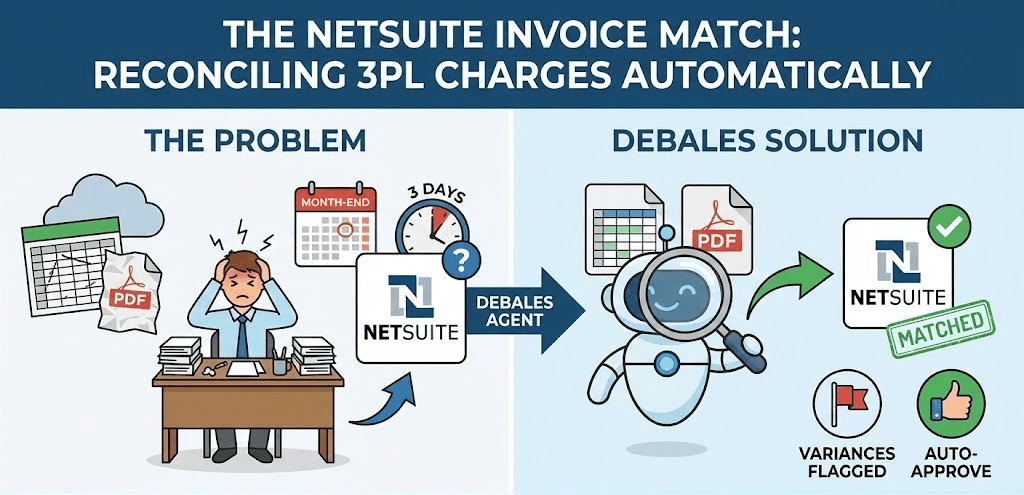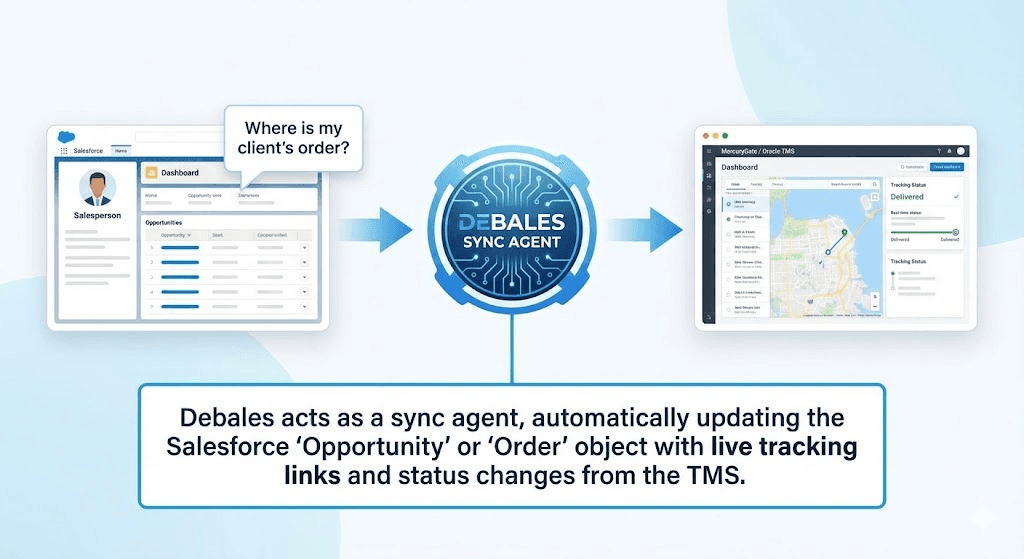How AI Detects and Prevents Fraud and Theft in the Supply Chain?
Wednesday, 1 Oct 2025
|
How AI Detects and Prevents Fraud and Theft in the Supply Chain
Cargo theft and supply chain fraud represent a $100+ billion annual drain on global logistics—a staggering figure that continues growing as criminal operations become increasingly sophisticated. Traditional security approaches struggle against modern threats: organized theft rings using AI themselves to identify high-value targets, invoice fraud schemes exploiting manual approval processes, and warehouse employees committing "low and slow" theft that accumulates unnoticed for months.
The challenge compounds as supply chains digitize. While technology enables efficiency, it creates new vulnerabilities: fake invoices generated through deepfake impersonation, sophisticated freight broker fraud, GPS spoofing diverting entire shipments, and insider collusion coordinated through encrypted communications. Manual audits, periodic inspections, and traditional CCTV surveillance simply cannot keep pace with the scale, speed, and sophistication of modern supply chain fraud.
AI-powered fraud detection and theft prevention transforms reactive security into predictive protection. Organizations implementing comprehensive AI security systems report 82% reduction in theft-related losses, $2.5 million+ in annual savings, 95%+ fraud detection accuracy, and real-time threat response within seconds rather than hours or days. For logistics leaders facing mounting security threats, understanding how AI safeguards supply chains isn't optional—it's essential for protecting assets, reputation, and profitability.
Wondering how AI detects fraudulent invoice patterns or suspicious warehouse behavior invisible to humans? The answer lies in machine learning algorithms analyzing millions of transactions and behavioral patterns to spot anomalies.
The Modern Supply Chain Fraud and Theft Landscape
Supply chain security threats have evolved dramatically:
Organized Cargo Theft: Criminal rings now use AI themselves to analyze freight patterns, identify high-value shipments, and execute sophisticated theft schemes including GPS spoofing and fraudulent pickup orders
Invoice and Payment Fraud: Fake invoices, overbilling schemes, duplicate payments, and fraudulent vendor registrations cost companies billions annually
Warehouse Shrinkage: Internal theft by employees or contractors, often through small, repeated incidents that accumulate substantial losses over time
Counterfeit Products: Fake goods entering supply chains damage brands and create safety risks, particularly in pharmaceuticals and electronics
Return Fraud: Fraudulent returns including wardrobing, receipt fraud, and stolen merchandise returns
Cyber-Enabled Fraud: Digital attacks including ERP system manipulation, document forgery using deepfakes, and identity spoofing
For context on AI's broader role in logistics, explore What Exactly Is AI in Logistics and Supply Chain Management?.
How AI Detects and Prevents Supply Chain Fraud
1. Real-Time Behavioral Anomaly Detection in Warehouses
AI-powered computer vision systems monitor warehouse operations 24/7, detecting suspicious behaviors that indicate theft or unauthorized access.
Behavioral monitoring capabilities:
- Unauthorized zone access: AI detects when individuals enter restricted areas or access inventory outside authorized times
- Loitering detection: Systems flag unusual lingering near high-value cargo or security blind spots
- Tampering recognition: Computer vision identifies attempts to manipulate price tags, labels, or packaging
- Abnormal movement patterns: AI distinguishes between normal work activities and suspicious behavior indicating theft intent
Real-world success: A Singapore logistics hub deployed viAct AI-based theft detection system achieving an 82% drop in theft-related losses within six months, saving close to $2.5 million annually. The system flagged an unauthorized person entering a cargo bay after midnight—while guards assumed it was a late-shift worker, AI detected no badge entry data and raised instant alerts, intercepting the intruder before any cargo was taken.
Technical advantage: Unlike passive CCTV recording, AI actively interprets intent—distinguishing between a worker unloading goods versus someone loitering with unusual movements. Alerts reach supervisors within 5 seconds of detecting suspicious activity.
Discover visual intelligence capabilities in How Computer Vision Technology Helps in Logistics Operations.
2. Machine Learning for Invoice and Payment Fraud Detection
AI analyzes transaction patterns to identify fraudulent invoices, duplicate payments, overbilling schemes, and unauthorized vendor registrations.
Fraud detection patterns:
- Duplicate invoice detection: ML algorithms identify invoices with identical or suspiciously similar amounts, vendors, or descriptions
- Overbilling identification: AI compares invoiced amounts against historical pricing, market rates, and contractual agreements
- Fake vendor detection: Systems flag newly registered vendors with suspicious characteristics or connections to existing fraud patterns
- Payment timing anomalies: Unusual payment request urgency or off-cycle submissions triggering alerts
Advanced techniques: Natural language processing analyzes invoice text for inconsistencies, while network analysis detects suspicious vendor relationships or shell company patterns. Supervised machine learning models trained on historical fraud cases achieve 95%+ detection accuracy.
Business impact: Companies implementing AI procurement fraud detection reduce fraudulent payments by 20-30% while accelerating legitimate payment processing through automated approval of verified transactions.
Learn about data requirements in What Kind of Data is Needed to Train an Effective AI Model for Supply Chain Optimization?.
3. Cargo Theft Prevention Through Predictive Analytics
AI predicts theft risk by analyzing shipment characteristics, route patterns, and historical theft data—enabling proactive security measures.
Predictive risk scoring:
- Shipment value assessment: AI identifies high-value cargo requiring enhanced security
- Route risk analysis: Machine learning scores theft likelihood by analyzing historical incidents, geographic patterns, and route characteristics
- Timing vulnerability: Systems identify high-risk time windows (holidays, overnight, unattended periods)
- Driver behavior patterns: Anomaly detection flags unusual route deviations or unauthorized stops
Real-time monitoring: GPS tracking integrated with AI detects suspicious patterns such as unexpected route changes, prolonged stops in high-risk areas, or transponder tampering attempts—alerting security teams immediately for intervention.
Example: Overhaul's AI system recently identified a single container on a near-mile-long train in Indiana through pattern analysis, leading to a rare successful recovery of stolen rail cargo.
Strategic deployment: By predicting which shipments face highest theft risk, companies allocate security resources (armed escorts, GPS tracking, secure parking) more cost-effectively rather than blanket approaches.
4. Counterfeit Product Detection and Authentication
AI combats counterfeit goods through visual inspection, blockchain verification, and authenticity scoring.
Authentication methods:
- Computer vision inspection: AI analyzes product images, packaging, labels, and holograms to detect counterfeits
- Serial number verification: Machine learning validates batch numbers, warranties, and certification against manufacturer databases
- Blockchain integration: AI-verified product authenticity recorded on immutable ledgers throughout supply chain
- Supplier vetting: Algorithms assess supplier legitimacy through document verification, business history analysis, and network mapping
Industry application: Pharmaceutical companies use AI to verify drug authenticity, preventing dangerous counterfeits from entering distribution channels. Consumer electronics manufacturers similarly protect against fake products damaging brand reputation.
5. Return Fraud Detection
AI identifies fraudulent return patterns including wardrobing, receipt fraud, and return abuse.
Detection capabilities:
- Serial returner identification: ML flags customers with unusual return frequencies or patterns
- Product condition verification: Computer vision detects when returned products show signs of use inconsistent with legitimate returns
- Switch fraud detection: AI identifies when different products are returned than originally shipped
- Receipt fraud prevention: Algorithms detect manipulated receipts or suspicious purchase patterns
Business impact: AI-driven return fraud detection reduces fraud-related losses by 20%+ while maintaining positive customer experiences for legitimate returns.
Learn about reverse logistics in How AI Assists in Managing Reverse Logistics (Customer Returns).
6. Insider Threat Detection Through Behavioral Analytics
AI identifies internal fraud by analyzing employee access patterns, transaction behaviors, and system usage.
Insider threat indicators:
- Abnormal system access: Detecting when employees access data or systems outside normal job functions
- Transaction pattern anomalies: Identifying unusual order modifications, inventory adjustments, or approval overrides
- Collaboration networks: Mapping suspicious communication or transaction patterns between employees and external parties
- Time-based anomalies: Flagging activities occurring during unusual hours or from unexpected locations
Ethical implementation: AI insider threat detection must balance security with privacy, focusing on behavioral anomalies rather than individual surveillance, with appropriate governance and transparency.
7. Supply Chain Visibility for Fraud Prevention
End-to-end visibility powered by AI enables fraud detection across entire supply chains.
Visibility-enabled security:
- Document verification: AI validates bills of lading, customs documents, and certificates of origin for consistency
- Shipment tracking: Real-time monitoring detects when cargo deviates from expected routes or timelines
- Supplier transparency: Blockchain-verified supplier credentials and transaction histories
- Audit trail automation: Complete traceability supporting forensic investigations when fraud occurs
Understand visibility capabilities in How AI Enhances Supply Chain Visibility from End to End.
Real-World Fraud and Theft Prevention Success Stories
Singapore Logistics Hub: 82% Theft Reduction
A major Singapore logistics facility deployed viAct AI surveillance system:
Challenge: Recurring cargo thefts causing substantial financial losses and reputation damage
Solution: Computer vision-based monitoring with real-time behavioral analysis, instant alerting, and 24/7 AI vigilance
Results:
- 82% drop in theft-related losses within 6 months
- $2.5 million in annual savings from reduced theft and insurance claims
- 30% reduction in manpower needs through AI-optimized security staffing
- Faster response times (alerts within 5 seconds vs. retrospective video review)
Manufacturing Company: Supplier Fraud Detection
A car manufacturer implemented ML-based supply chain fraud detection:
Implementation: Supervised machine learning analyzing supplier data, transaction patterns, and documentation for fraud indicators
Capabilities: Automated flagging of suspicious supplier behaviors, fake documentation, and invoice anomalies
Impact:
- Detection of various fraud types including invoice manipulation and counterfeit parts
- Improved supplier vetting and onboarding processes
- Enhanced procurement integrity and cost control
debales.ai Client: Warehouse Inventory Protection
A debales.ai warehouse client implemented AI behavioral monitoring:
Technology: AI models detecting behavioral anomalies including repeated unauthorized zone access, unusual timing patterns, and suspicious stock movements
Approach: Cameras paired with intelligent analysis rather than passive recording
Outcomes:
- Significant reduction in inventory shrinkage
- Real-time alerts enabling immediate intervention
- Complete audit trails supporting investigations
Explore related quality control in Can AI Be Used for Automated Quality Control in Logistics?.
Measurable Business Benefits
Organizations implementing AI-powered fraud and theft prevention report consistent improvements:
Financial Impact
- 82% reduction in theft-related losses in warehouse environments
- $2.5 million+ annual savings from prevented theft and reduced insurance costs
- 20-30% decrease in fraudulent payments through invoice validation
- Significant ROI typically within 12-18 months of deployment
Operational Efficiency
- Real-time alerts within 5 seconds vs. hours for manual review
- 30% reduction in security manpower through AI-optimized staffing
- 95%+ fraud detection accuracy surpassing manual audit capabilities
- 24/7 monitoring without fatigue or attention lapses
Risk Mitigation
- Proactive threat prevention rather than reactive response after losses occur
- Complete audit trails supporting investigations and prosecutions
- Enhanced supplier trust through verified authentication and transparency
- Reduced insurance premiums from demonstrable security improvements
Strategic Advantages
- Brand protection preventing counterfeits from damaging reputation
- Regulatory compliance meeting security and traceability requirements
- Customer confidence in product authenticity and supply chain integrity
- Competitive differentiation through superior security posture
How debales.ai Enables Intelligent Fraud and Theft Prevention
At debales.ai, our AI platform delivers comprehensive supply chain security intelligence:
Behavioral Anomaly Detection: Computer vision monitoring warehouse operations with real-time alerts for suspicious activities
Transaction Fraud Analysis: Machine learning identifying invoice fraud, payment anomalies, and procurement irregularities
Predictive Risk Scoring: AI assessing cargo theft likelihood enabling proactive security resource allocation
Authentication Verification: Multi-factor product and supplier validation preventing counterfeits
Return Fraud Detection: Pattern recognition identifying fraudulent return behaviors
Insider Threat Analytics: Behavioral analysis detecting internal fraud while respecting privacy
End-to-End Visibility: Complete supply chain transparency enabling fraud detection at every touchpoint
Explainable AI: Transparent reasoning showing why alerts are generated and what patterns indicate fraud
Our approach combines security intelligence with the broader orchestration capabilities described in What is an AI-Powered Control Tower in Logistics?.
Implementation Best Practices
Successful AI fraud prevention deployments follow structured approaches:
Phase 1: Risk Assessment
- Identify highest-risk fraud and theft scenarios
- Analyze historical loss data and vulnerability points
- Prioritize implementation based on potential impact
Phase 2: Technology Integration
- Deploy computer vision systems in high-risk warehouse zones
- Integrate AI with existing ERP, WMS, and transaction systems
- Establish alert protocols and response procedures
Phase 3: Model Training
- Train ML models on historical fraud patterns
- Validate detection accuracy against known fraud cases
- Continuously refine algorithms as new patterns emerge
Phase 4: Governance and Ethics
- Establish clear policies balancing security with privacy
- Ensure transparency in AI decision-making
- Provide oversight mechanisms preventing algorithmic bias
Phase 5: Continuous Improvement
- Monitor detection accuracy and false positive rates
- Update models as criminal tactics evolve
- Expand AI coverage based on proven ROI
The Future: AI Arms Race in Supply Chain Security
As criminals increasingly leverage AI for sophisticated fraud schemes, defensive AI must evolve continuously. Next-generation systems will integrate federated learning (enabling fraud detection model sharing without exposing proprietary data), adversarial AI (testing defenses against AI-powered attacks), and autonomous response systems (automatically implementing countermeasures when threats are detected).
This vision aligns with the digital twin concept explored in What is a Digital Twin and How is it Used in Logistics AI?.
Strategic Imperative: Security as Competitive Advantage
With cargo theft and fraud costing $100+ billion annually, security isn't just loss prevention—it's competitive differentiation. Organizations demonstrating superior security through AI gain customer trust, reduce insurance costs, protect brand reputation, and operate more efficiently than competitors still relying on manual security approaches.
The question isn't whether AI can detect and prevent supply chain fraud—proven implementations demonstrate it can. The question is how quickly your organization deploys AI to protect assets before criminals exploiting AI themselves gain further advantage.
Ready to transform supply chain security from reactive response into predictive protection?
Discover how debales.ai's AI-powered platform delivers real-time fraud detection, behavioral monitoring, and predictive risk intelligence—safeguarding assets, reputation, and profitability while reducing losses by 82%.
Book a demo with debales.ai today and experience supply chain security reimagined for the AI era.
All blog posts
View All →
Monday, 1 Dec 2025
NetSuite 3PL Billing Automation: Catch Pricing Errors Instantly
3PL sends messy spreadsheets/PDF invoices monthly. Accounting wastes 3 days matching against NetSuite. Debales agent auto-reconciles line-by-line, flags pricing errors, and approves matches instantly.

Sunday, 30 Nov 2025
Live Shipment Status in Salesforce: MercuryGate/Oracle TMS Sync
Sales reps ping ops via Slack for shipment status because Salesforce lacks live TMS data from MercuryGate/Oracle. Debales syncs tracking links and status directly to Opportunity/Order objects automatically.

Saturday, 29 Nov 2025
Fixing Inventory Sync Lag Between Shopify and Legacy WMS
Oversold inventory from Shopify and legacy WMS sync lag costs sales and customers. Learn how Debales AI bridges these with real-time order-driven inventory reservation to prevent stockouts.